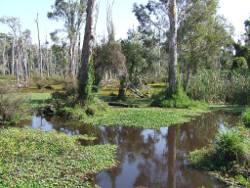Quick facts
- 1841
- flooding reached the highest ever levels in the Brisbane region. In Ipswich the waters rose '55 feet above the ordinary height of the Bremer'[1]
- 1877
- All States were affected by drought with disastrous losses in Queensland. In Western Australia many native trees died, wetlands dried up and crops failed[4]
The main features of water regime include timing and predictability, frequency, duration, extent and depth, variability and rate of change[2].
| Feature definition |
Definition |
| Timing or predictability |
- When water is present
- Within year-patterns are most important in seasonal wetlands whereas among-year patterns and variability in timing are relevant to temporary wetlands.
- Can mean the month or season when a flow event is likely to occur and can be determined annually, within a season, or over a decade
- Predictability means the degree to which flow events occur at particular times of the year or at particular intervals of time.
- Flooding is typically far less predictable in arid regions for any given year, where flood frequencies and timing depend on regional climatic factors and erratic local rainfall and run-off[3].
|
| Frequency |
- How often filling and drying occur over time
- Ranges from zero to frequent filling and drying in shallow wetlands many times throughout the year
- For example, a 100-year flood means the size of flood that is equalled or exceeded once in 100 years. This 1-in-100 chance means that there is a 1% probability of such a flood occurring in any given year.
|
| Duration |
- Period of inundation or the discharge event
- Days to years, varying within and among wetlands
- Rates of rise and fall may be important
|
| Extent and depth |
- The area of inundation and depth of water
- Water depth affects light penetration and other variables
|
| Variability |
- The degree to which these above features change at a range of time scales
|
| Rate of change |
- Refers to the ‘flashiness’ or stability of a river system.
- ‘Flashy’ streams have very rapid rates of rise in flow (and often of fall in flow). Stable streams have a steady pattern of flow, and any changes take place relatively slowly.
|
References
- ^ Telegraph. Australia floods: History of Queenslands worst floods. [online] Available at: http://www.telegraph.co.uk/news/worldnews/australiaandthepacific/australia/8256385/Australia-floods-history-of-Queenslands-worst-floods.html [Accessed 16 August 2012].
- ^ Boulton, AJ & Brock, MA (1999), Australian Freshwater ecology: prcesses and management, no. Australian Freshwater ecology:processes and management, Cooperative research Center for Freshwater Ecology, Gleneagles publishing, Australia.
- ^ Queensland Museum (2022), Wetlands of Queensland Book, p. 437, Queensland Museum, Brisbane, Queensland.
- ^ R., N (2009), Drought Assessment, Capital Printing Company, India.
Last updated: 14 August 2023
This page should be cited as:
Department of Environment, Science and Innovation, Queensland (2023) Water regime, WetlandInfo website, accessed 8 May 2025. Available at: https://wetlandinfo.des.qld.gov.au/wetlands/ecology/processes-systems/water/hydrology/regime/

 — Department of the Environment, Tourism, Science and Innovation
— Department of the Environment, Tourism, Science and Innovation


